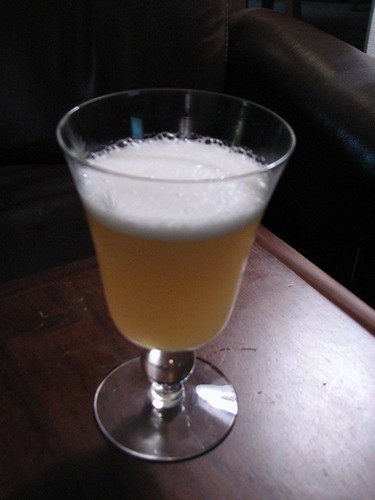 This all starts with a stocking stuffer my father-in-law gave me for Christmas a couple of years ago, the July/August 2007 issue of Imbibe Magazine. They had an article pisco, on the brandy of Peru and (though highly disputed by Peruvians apparently) Chile. This intrigued me, an so begins a short pisco lesson (okay, a bunch of stuff that a I stole from elsewhere on the internet). Pisco begins like any brandy, by distilling fermented crushed grapes. Unlike more traditional brandies, the eau de vie (unaged alcoholic distillate) is put into short clay jugs that are lined with beeswax, called a Pisco. Wikipedia, the font of all mostly-true knowledge, claims that it can now be aged for a minimum of three months in glass, stainless steel or other inert material. Peruvian Pisco falls into four categories:
This all starts with a stocking stuffer my father-in-law gave me for Christmas a couple of years ago, the July/August 2007 issue of Imbibe Magazine. They had an article pisco, on the brandy of Peru and (though highly disputed by Peruvians apparently) Chile. This intrigued me, an so begins a short pisco lesson (okay, a bunch of stuff that a I stole from elsewhere on the internet). Pisco begins like any brandy, by distilling fermented crushed grapes. Unlike more traditional brandies, the eau de vie (unaged alcoholic distillate) is put into short clay jugs that are lined with beeswax, called a Pisco. Wikipedia, the font of all mostly-true knowledge, claims that it can now be aged for a minimum of three months in glass, stainless steel or other inert material. Peruvian Pisco falls into four categories:
- Puro— made from a single variety of grape, usually the traditional Quebranta.
- Aromatic— Again, made from a single variety, but usually on of the Muscat family.
- Mosto Verde (Green Must)—distilled from grape must, the crushed grapes including the solids called pomace that has only partially fermented and contains residual grape sugars.
- Acholado (Half-breed)—a blended of musts or wine from several varieties of grape.
This is all particularly fascinating since all but one of the four or five piscos that I have found give any indication as to which category they belong. According to Imbibe, during the middle of the 19th century, there was extensive trade between San Francisco and Peru. This led to pisco being San Francisco’s top-selling liquor with the prospecting gold rush crowd. It however did not fare will after prohibition and so, until this article, I had never heard of the stuff. But that fact all the more piqued my interest, so being Wisconsin, we headed to one of the most bizarre liquor stores that I have ever been in, Club Liquor in Neenah-Menasha, WI. From the outside it looks like a seedy tavern-liquor store combo. Inside, while it isn’t what you might call a fin retail establishment, they have everything including a COUPLE of $150 bottle of Jonnie Walker blue label just sitting on the shelf. Well, I picked up a bottle of Don Cesar Pisco Puro and made a pisco sour for the family. All in all, everybody pretty much liked it. So, we decided to get some when we got back to California and picked up some Pisco Montesierpe, a venerable old brand.
Pisco Sour
- 3 oz. pisco
- 2 oz. simple syrup
- 1 oz. fresh-squeezed lemon juice
- 1 egg white
- 2 dashes Angostura bitters
Shake vigorously with ice and strain into a cocktail glass.
This cocktail uses an egg white to add body and froth to the drink. It really is quite good, but the egg white does tend to freak out many people. Just remember booze kills bacteria; lemon juice kills bacteria. If this doesn’t help, buy pasteurized eggs (and then don’t tell your guest until the second one).
It is interesting, the Don Cesar had a less aggressive, less plant-like taste than the Pisco Montesierpe. Our Pisco Montesierpe reminded me a little of rhum agricole, which is made from cane juice rather than molasses. I don’t know type of Pisco it is, I am guessing it’s probably the acholado. If you know or want to hazard a better guess, leave a comment. I actually think that the Don Cesar makes a bit more balanced pisco sour. At any rate the Montesierpe has a more intense, though harsher flavor.
Leave a Reply to JayJay Cancel reply